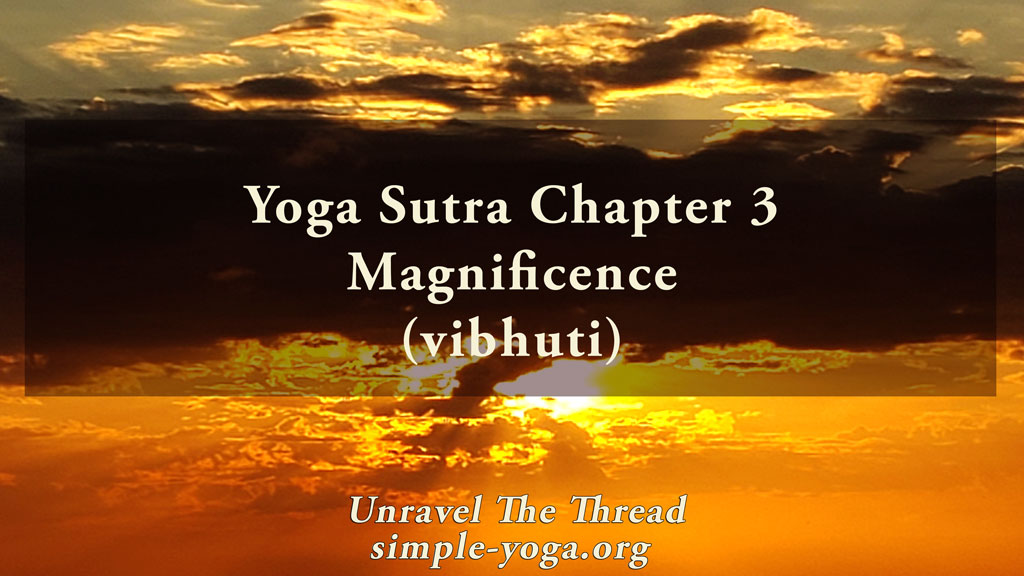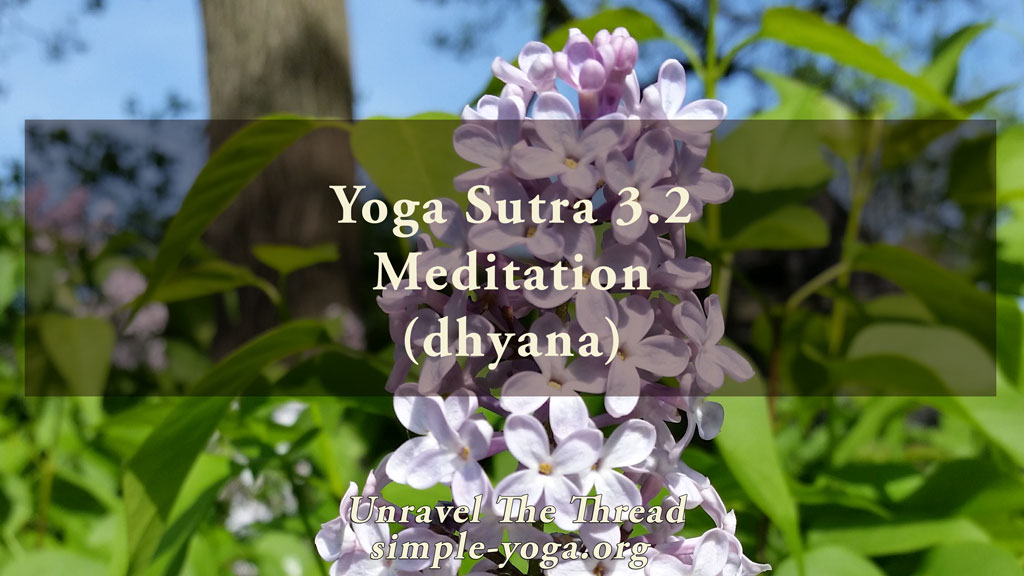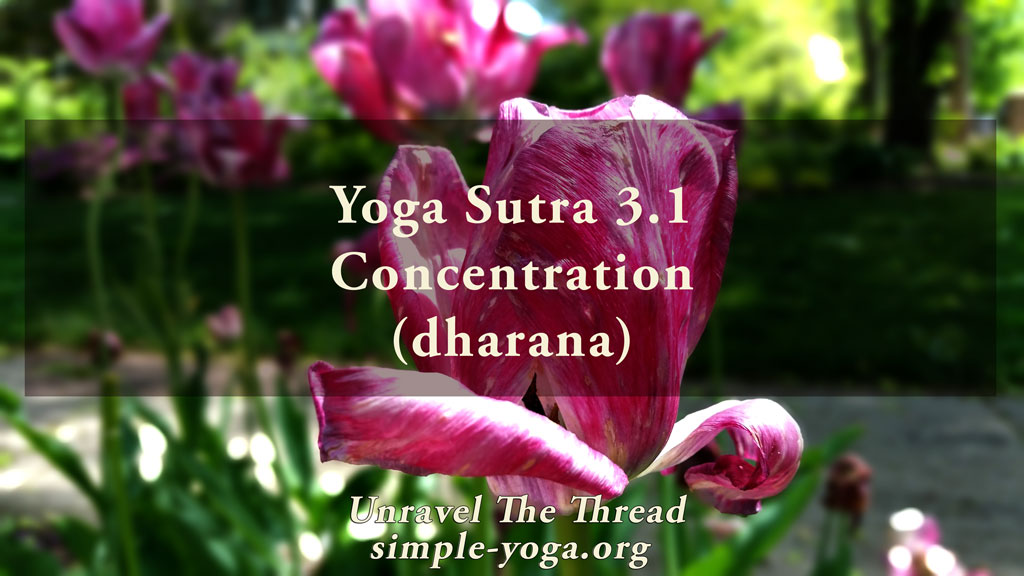
Chapter 3 Magnificence – Introduction
May 18, 2021
3.2 Meditation – dhyana
May 30, 2021
Chapter 3 Magnificence – Introduction
May 18, 2021
3.2 Meditation – dhyana
May 30, 20213.1 Concentration – dharana

3.1 Concentration (dharana) is directing the mind to a specific point.
Chapter Three of the Yoga Sutra continues the journey along the eight limbs of yoga. The preparatory steps have been completed, the seeds of unconditional love have been planted (yamas), contentment is setting the stage for the journey (niyamas), body function has been optimized (asana), improved vital energy flow contributes to enhancing sensitivity of the subtler aspects of your being (pranayama), and your senses have been directed inwardly for internal exploration (pratyahara). Following these steps has strengthened your capacity to direct your mind. It is evident that whatever you practice establishes a pattern that grows stronger over time. Throughout your exploration you have become more familiar with your ways of being and their effects as well as with effective ways for regulating them to improve the quality of your participation in your daily activities and interactions. In Sanskrit, dharana means to hold, to bear, to keep in remembrance, to assume the shape of. The exercises in the earlier portion of this journey guided you to explore what you make important enough to dedicate your time, energy, and attention to. This sutra invites you to direct your awareness to that same question. What is important enough for you to focus on? Have you noticed how focusing mostly on temporary experiences and goals often results in riding an emotional rollercoaster from success to defeat, from dissatisfaction to feeling accomplished? Remember that Patañjali suggested single-pointed focus in 1.32 as an effective way of reducing distractions. In addition, sutra 1.16 indicated that awareness centered on truth is beyond distractedness. Sutra 1.23 may also be interpreted as a way to release distractedness by relinquishing the illusion of control and accepting life unconditionally, exactly as it is. Then, all worries and tendencies to manipulate the world are removed.
Currently, the word meditation is used to talk about a wide range of practices. For instance, setting intentions and visualizations are often considered meditation. However, from the perspective presented in this aphorism, it is more accurate to think of intention setting and visualizations as concentration practices directed to set a meaningful path facilitative of wholehearted action. This interpretation articulates with the idea of dharma. Dharma is a Sanskrit word that can be interpreted as duty, life purpose, and living according to one’s conscience. Moreover, this interpretation complements the call for single-pointed focus suggested in aphorism 1.32 as the way to remove distractions on the path to self-realization (1.30 & 1.31).
As you attempt to focus, notice what draws your attention away from your goal. Remember from the section on afflictions in Chapter Two of the Yoga Sutra that quite likely, who you think you are or should be will keep interfering with your goal. In the yoga tradition, there are very simple and specific focal points for concentration including the center of the pelvis, the solar plexus at the top of the upper abdomen just below the lower tip of the breastbone, the center of the chest, the center of the throat, the base of the tongue, the tip of the tongue, and the middle point between the eyebrows. When focusing your attention on any of these points, remember the basic guideline: There will be distractions. Just keep bringing your attention to your focal point without strain, struggle, or self-judgment, and with a gentle smile. To set yourself up for concentration you can apply the previous five limbs of yoga practice: First, invite gratitude and love for yourself and your life (yamas). Second, make peace with yourself and choose to be content with yourself and your life (niyamas). Third, find a steady and enjoyable posture, free of struggle and conducive to being endlessly focused (asana). Fourth, connect with your natural breath, feeling the sensations that arise with each easeful inhalation and exhalation, until your breath feels quite subtle and effortless (pranayama). Fifth, be curious to experience the aliveness in your body directly, by sensing the internal experience of being (pratyahara).
For concentration (dharana), rest your attention on one of the focal points listed above and witness whatever is happening without attaching opinions, stories, or expectations to what you are experiencing. Be with what is as it is and with yourself as you are. It can be useful to recognize that no number of words can ever encapsulate the immersive richness of being you. Welcome whatever arises and remain attentive to your focal point. Keep the technique simple by remembering that the experiences that come and go, regardless of how enjoyable or uncomfortable they may be, are not what you are concentrating on. They are the byproducts of your concentration, so stay with your focal point. After you are finished, reflect on how you felt before, during and after your concentration practice.
Are there any patterns in the distractions that you notice?
Are there some expectations interfering with your intention to concentrate?
Are some of those expectations tied to your sense of identity, like who you should be or are expected to be?
As usual, one more way of exploring the meaning of this sutra is by chanting it.
You can choose to chant it in its traditional form with some of the words coming together:
देशबन्धः चित्तस्य धारणा ॥१॥
deśabandhaḥ cittasya dhāraṇā ॥1॥
Another option is to chant each word in the sutra individually:
- deśa
- bandhaḥ
- cittasya
- dhāraṇā
If you prefer, you may listen to the podcast:
Unravel the thread is now available as a book!
If you find Simple-Yoga.org and Unravel the thread useful, consider supporting my labor with a donation, you may also donate using PayPal or Venmo. Thank you!
